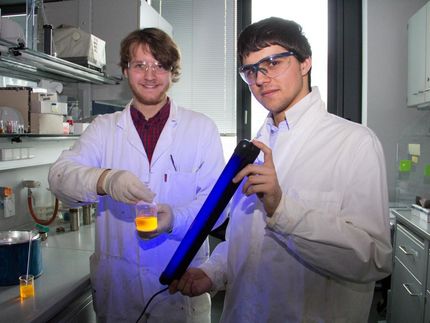Expanding when it shouldn't
New material with exceptional negative compressibility
Our intuition tells us that a sample of material compressed uniformly from all sides should reduce its dimensions. Only a few materials subjected to hydrostatic compression exhibit the opposite behaviour, expanding slightly in one or two directions. At the Institute of Physical Chemistry of the Polish Academy of Sciences a material has been discovered with exceptionally high negative compressibility and a previously unknown mechanism responsible for it.
When you squeeze something, you usually expect it to shrink, particularly when the pressure exerted acts uniformly from all sides. However, there are materials which when subjected to hydrostatic pressure elongate slightly in one or two directions. During the search for optimal compounds for hydrogen storage at the Institute of Physical Chemistry of the Polish Academy of Sciences (IPC PAS) in Warsaw an accidental, albeit very interesting, discovery has been made: while the pressure was being increased one of the tested materials suddenly elongated significantly.
"Usually the increase in dimensions observed in materials with negative compressibility subjected to high hydrostatic pressure is small. We are talking here about values of the order of a single percentage point or even less. We have found a material of very high negative compressibility, of up to 10% in one direction. Interestingly, the elongation occurred abruptly at a pressure of approx. 30 thousand atmospheres," says Dr. Taras Palasyuk (IPC PAS).
Dr. Palasyuk is conducting research on materials subjected to hydrostatic pressures of one to several million atmospheres (the prefix hydro- means that the pressure acts on the material from all sides). Such high pressures are produced in the laboratory using diamond anvils, between which a micrometre-sized sample is placed. The sample is in a seal ensuring that the exerted pressure acts on the test material uniformly from all directions. To lead to an increase in pressure, the anvils are compressed by means of a screw. A ruby crystal placed next to the sample acts as a pressure gauge. It changes its mode of fluorescence depending on the pressure exerted upon it.
The volume of the material samples exposed to increasing pressure decreases, which is associated with a reduction of usually all spatial dimensions. However, there are also atypical crystalline materials whose volume decreases during compression (because according to thermodynamics it must) whilst at the same time the crystal elongates in one or two directions. The mechanism responsible for this elongation has always been of a geometric nature: under pressure individual elements of the crystal structure simply moved relative to each other to varying degrees in different directions.
"In our laboratory using laser light we analyzed how the manners of vibration of molecules in the crystal changed with increasing pressure and on this basis we drew conclusions about the structure of the material. We quickly discovered that in the crystal we were examining, which was sodium amidoborane, the elongation could not be explained by changes in geometry alone," says PhD student Ewelina Magos-Palasyuk, the lead author of the publication in the journal Scientific Reports.
Sodium amidoborane is a relatively readily available compound with the chemical formula Na(NH2BH3) forming transparent crystals with an orthorhombic structure. The results of research on crystals of this compound obtained at the IPC PAS using Raman spectroscopy were confronted with theoretical model predictions. It turned out that the negative compressibility of sodium amidoborane crystals has to be a consequence of the elongation of the chemical bonds between nitrogen and hydrogen and boron and nitrogen, caused by the abrupt formation of new hydrogen bonds between adjacent molecules in the crystal.
"Sodium amidoborane is thus the first material known to us where the negative compressibility is primarily of a chemical nature," says Dr. Taras Palasyuk and stresses that in contrast to other materials, in which the which the symmetry of the crystal structure changes under high pressure, in sodium amidoborane there are no drastic changes. He adds: "Our preliminary results, obtained by X-ray diffraction at the National Synchrotron Radiation Research Center in Taiwan, also confirm that the material retains its original symmetry. It is precisely because it does not have to rebuild that the increase in the linear dimensions occurs here in such an abrupt manner."
The discovery of a previously unknown mechanism responsible for negative compressibility opens up interesting avenues in the search for new materials with similarly exotic physical properties. However, the first applications can already be thought of right now. The significant, abrupt and reversible increase in length of the sodium amidoborane crystals at a clearly defined value of pressure makes the material an interesting candidate for e.g. components of detectors of a certain threshold pressure of approx. 30 thousand atmospheres (in industry pressures as high as up to 300 thousand atmospheres are used). Another potential application of sodium amidoborane could be active bulletproof vests, which would behave like airbags in a car under the influence of the sharp increase in pressure caused by the missile strike.
Original publication
Other news from the department science
Most read news
More news from our other portals
See the theme worlds for related content
Topic World Spectroscopy
Investigation with spectroscopy gives us unique insights into the composition and structure of materials. From UV-Vis spectroscopy to infrared and Raman spectroscopy to fluorescence and atomic absorption spectroscopy, spectroscopy offers us a wide range of analytical techniques to precisely characterize substances. Immerse yourself in the fascinating world of spectroscopy!

Topic World Spectroscopy
Investigation with spectroscopy gives us unique insights into the composition and structure of materials. From UV-Vis spectroscopy to infrared and Raman spectroscopy to fluorescence and atomic absorption spectroscopy, spectroscopy offers us a wide range of analytical techniques to precisely characterize substances. Immerse yourself in the fascinating world of spectroscopy!































































